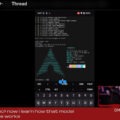Linux 5.0 is ready for public consumption, LibreSignage is looking for testers, Tympan is developing open source hearing aid hardware, and DOSing a Raspberry Pi.
Subscribe:
Listen:
Download:
Subscribe Spotify | Pandora | TuneIn | RSS | More
Colour key – Venn Jill Pedro
- As we mentioned in January, kernel 5.0 includes AMD FreeSync support.
- RasPi touchscreen support in the mainline kernel for the official 7″ touchscreen available at raspberrypi.org.
- Installed in from the pps mainline and it’s not caused any issues.
- Had to use the DO NOT USE nvidia ppa.
- No major changes because it’s a fingers and toes release.
- Comes with Google’s Adiantum storage encryption system.
- Adiantum works on low-powered devices such as Android smartphones.
- There’s also a workaround in place now to help combat memory fragmentation.
- Intel Gen11 graphics support
- Support for Turing means you’ll be able to at least boot into a graphical session (with software rendering), if you have one of the new NVidia GPUs.
- Kinda want kernel 5 in Solus, for no other reason than new!
- MiyoLinux, or “make it your own linux” is intended for older hardware, and is a derivative of the free of systemd Debian distro Devuan.
- It is so refreshing to use a lightweight distro again, one that is fast, free of systemd and is under 500 Megs!
- The user chooses their software/applications they want installed and the i3, Awesome or Openbox Window managers.
- Oh you have to setup your own partitions, retro.
- It’s apt based.
- I can’t help but feel like, if this is what you’re going for, Bunsen Labs (continuation of Crunchbang) is possibly the better alternative
- Yeah, it’s bigger but will require a lot less work to get up and running.
- Yup, still green!
- It is an open source alternative to PLEX, and is a fork of Emby.
- Thanks to The-Mentor in chat.
- It’s available in the AUR along with standalone binaries and a Ubuntu repo.
- Chromecast is supported when using Google Chrome (desktop) or Android.
- Jellyfin Cordova app for Android exists.
- Is this the fork of Emby that basically offers all functionality that is now only available to paying customers of that software?
- It really does seem some projects go freemium.
- Only $299, this is wonderful, especially when hearing aids can cost thousands of dollars.
- Real-time digital signal processing in that small a package is neat for the price.
- It’s a bit bulky but could be a game changer for some.
- Headphones will be the tricky part.
- Even something like my el cheapo A18 tzar monitors at work are stratospherically expensive.
- Yeah, having a powerful and tiny base unit for cheaper is all well and good.
- But the actual sound output device is going to be the tricky part like Venn mentions.
- Handy for schools and the like.
- LibreSignage has a central server and a web interface for creating content and managing the signage network.
- You can manage all clients from the interface.
- Would be awesome to have dedicated images for client and server.
- Maybe someone out there is really bored and could look into that?!
- Even now that my internet is pretty good and my PC reasonably powerful, I still hate the idea of something going out to the web just to check the weather while I’m playing a game.
- Meteo is a nice weather app in Gnome because the notifications show up in the system tray and the Gnome Top Bar for current weather conditions.
- I have used the “curl http://wttr.in” in the command line before to view weather, and love it! Especially the ASCII art weather clouds.
- But honestly, lately I use our WeatherBot on Discord “It’s Raining Men” to check weather.
- Use Weather Update panel plugin for XFCE, like a normal person.
Slice of Pi
- There are two Astro Pis at the International Space Station that children from the European Space Agency’s Mission Zero program can do software experiments on.
- That’s a big number for any architecture.
- It’s QEMU and FreeDOS.
- This is for all my mechanic brothers & sisters out there with PCs from the 90s in the shop.
- OnMSFT blog telling people to use Linux… Strange world!
Feedback












